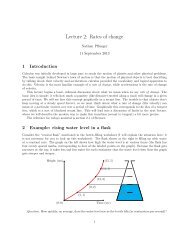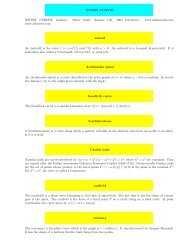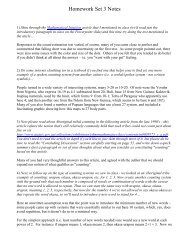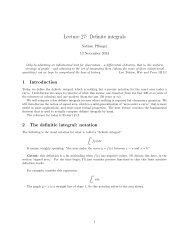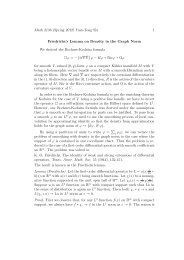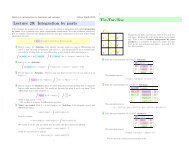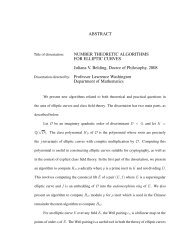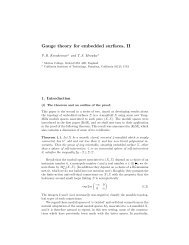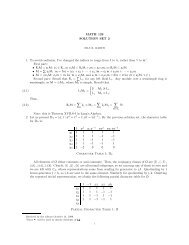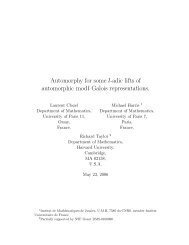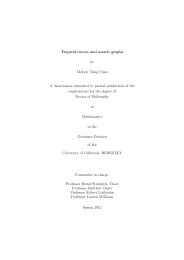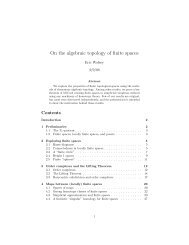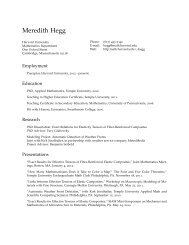Multilinear algebra
Multilinear algebra
Multilinear algebra
You also want an ePaper? Increase the reach of your titles
YUMPU automatically turns print PDFs into web optimized ePapers that Google loves.
2 Tensor products<br />
We begin with the result promised at the end of the previous section.<br />
Theorem 2.1. Any two vector spaces have a tensor product.<br />
Proof. Let V and W be vector spaces. Let E be the vector space of all formal linear combinations of symbols<br />
v ⊗ w where v ∈ V and w ∈ W . That is, an element of E is a finite sum ci(vi ⊗ wi), where the ci are<br />
scalars, vi ∈ V and wi ∈ W . Alternatively, E is a vector space with basis V × W , where we write the basis<br />
element coming from (v, w) as v ⊗ w.<br />
We now want to force the symbol ⊗ to represent a product. To do this, we let K be the subspace of E<br />
spanned by all elements of the form c(v ⊗ w) − cv ⊗ w, c(v ⊗ w) − v ⊗ cw, (v + v ′ ) ⊗ w − v ⊗ w − v ′ ⊗ w, and<br />
v ⊗ (w + w ′ ) − v ⊗ w − v ⊗ w ′ . That is, these are the elements such that if they were zero, that would say<br />
that ⊗ is a product. We then define V ⊗ W to be the quotient vector space E/K.<br />
We have a map µ : V × W → E → E/K = V ⊗ W where the first map sends (v, w) to v ⊗ w; we claim<br />
that this map is a universal product. First of all, it is a product: that’s exactly what modding out by K<br />
does. Now let λ : V × W → F be any other product. Note that since E and hence E/K is spanned by<br />
elements of the form v ⊗ w, there is at most one linear map T : V ⊗ W preserving the product. We thus<br />
want to show that one exists. We can first define a map ˜ T : E → F which sends v ⊗ w to v ⊗F w; this<br />
is well defined since {v ⊗ w} forms a basis for E. To turn ˜ T into our desired map T : E/K → F , we just<br />
need to show that K is contained in the kernel of ˜ T . But since ⊗F is a product, all the elements of K must<br />
become zero when you replace ⊗ with ⊗F , which is exactly what ˜ T does. Thus ˜ T (K) = 0 so we obtain a<br />
map T : E/K → F witnessing the universality of E/K.<br />
This constructions is explicit enough to tell us what an element of V ⊗ W looks like: it is a linear<br />
combination civi ⊗ wi. However, two such linear combinations can be equal, and they are equal exactly<br />
when they are forced to be equal by the fact that ⊗ is a product.<br />
Let’s now give a more concrete description of tensor products.<br />
As a first example of how we can actually compute tensor products, let’s let W = 0, the trivial vector<br />
space containing only 0. Then in V ⊗ 0, for any v ∈ V we have an element v ⊗ 0, and these will span all of<br />
V ⊗ 0. Now note that for any scalar c, c(v ⊗ 0) = v ⊗ (c · 0) = v ⊗ 0. But the only way this can happen for<br />
an element of a vector space is if v ⊗ 0 = 0! Indeed, if for example we let c = 2, we get 2(v ⊗ 0) = v ⊗ 0 so<br />
subtracting v ⊗ 0 from both sides gives v ⊗ 0 = 0.<br />
This means that every element of V ⊗ 0 is 0, i.e. V ⊗ 0 = 0.<br />
OK, let’s look at a more interesting example. Let W = k, the field of scalars, considered as a 1-dimensional<br />
vector space (if you are not comfortable thinking about vector spaces over general fields, you can assume<br />
k = R). To understand V ⊗ k, we need to understand products µ : V × k → E. Given such a product, for<br />
each v ∈ V we have an element µ(v, 1) ∈ E. Furthermore, for any other c ∈ k, by bilinearity (i.e., being<br />
a product), µ(v, c) = cµ(v, 1), so these elements µ(v, 1) determine µ. Also, bilinearity says that µ(v, 1) is<br />
linear as a function of v. Indeed, µ is bilinear iff µ(v, 1) is linear in v.<br />
Thus we have found that a product on V × k is the same thing as a linear map on V . But by definition,<br />
a product on V × k is the same thing as a linear map on V ⊗ k. Thus we should get the following.<br />
Proposition 2.2. For any V , V ⊗ k ∼ = V .<br />
Proof. To prove this rigorously, we have to give a product µ : V × k → V and show that it is universal. The<br />
only natural product to write down is µ(v, c) = cv, where the right-hand side is scalar multiplication in V .<br />
This is universal by the discussion above: given any other product λ : V × k → F , we get a map V → F by<br />
just sending v to λ(v, 1), and this preserves the product since it sends µ(v, c) = cv to λ(cv, 1) = λ(v, c).<br />
Finally, there is one more property that we need to compute general tensor products.<br />
Proposition 2.3. For any U, V , and W , (U ⊕ V ) ⊗ W ∼ = (U ⊗ W ) ⊕ (V ⊗ W ). The isomorphism sends<br />
(u ⊕ v) ⊗ w to (u ⊗ w) ⊕ (v ⊗ w).<br />
4



